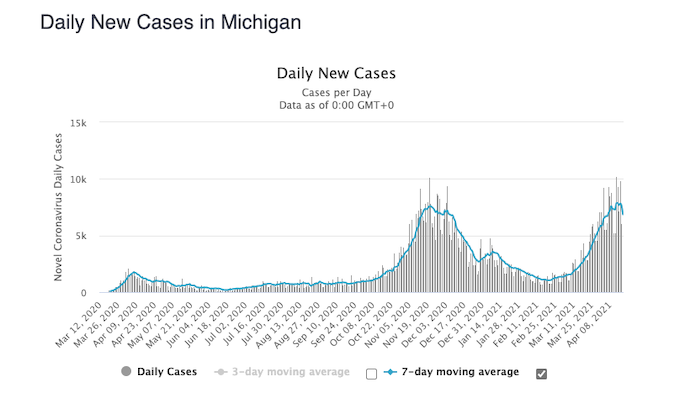- Joined
- Jul 10, 2008
- Messages
- 66,385
- Points
- 113
Wrong. Let us know when you plan to say anything factual for once.
https://www.npr.org/2021/04/15/9877...rian-crisis-with-more-than-3-000-deaths-a-day
razil COVID-19: 'Humanitarian Crisis' With More Than 3,000 Deaths A Day
April 15, 20215:56 PM ET
PHILIP REEVES
FacebookTwitter

A health worker treats a COVID-19 patient at a field hospital in Ribeirao Pires, greater Sao Paulo area, on Tuesday.
Andre Penner/AP
Health officials in Brazil say many hospitals are running dangerously short of sedatives and other crucial medications used for treating gravely ill COVID-19 patients.
They say some health services have already exhausted stocks of certain drugs, while others expect to do so within the next few days unless they receive fresh supplies.
The warning comes amid intense international concern over the spiraling pandemic in Brazil, where the average daily death toll has risen above 3,000, the highest in the world. To date, 365,444 people in the country have died of COVID-19, according to Brazil's health ministry.
Brazil's health crisis is being described as a "humanitarian catastrophe" by the international medical aid agency Doctors Without Borders (known by its French acronym, MSF), which has teams in parts of the country.
"The Brazilian authorities' ... refusal to adopt evidence-based public health measures has sent far too many to an early grave," MSF's international president Dr. Christos Christou said in a statement on Wednesday.
He said this has put Brazil in "a permanent state of mourning" and has caused "the near collapse of Brazil's health system."
Article continues after sponsor message
The alarm over the lack of medicines is being raised, in particular, by the country's richest and most populous state, São Paulo, which has so far registered almost one in four of Brazil's total COVID-19 deaths.
São Paulo's state government says its health services are facing "very serious" shortages, notably of muscle relaxants and sedatives needed for patients on respirators in intensive care units.
In a letter sent Tuesday to Brazil's Health Ministry, the state issued an urgent appeal for fresh supplies and accused the ministry of ignoring nine recent requests.
The scale of the problem has been underscored by a survey conducted by an organization representing local health officials: This found that more than two thirds of the 3,126 municipal health services in São Paulo were completely out of muscle relaxants, while 961 had no sedatives.
Front-line medical staff are reportedly turning to less effective alternative drugs, yet there have also been Brazilian media accounts of patients being tied by their arms to their beds to prevent them reacting violently to intubation when they wake up.
One of the country's leading news organizations, Folha de S. Paulo, recently published photographs and video of patients on respirators with their arms tied to the sides of their beds in a hospital in the northwestern city of Porto Velho.
Medicine shortages are adding to the already intense pressure on the country's intensive care units, where often exhausted and depleted staff are struggling to cope with a second wave of the pandemic, propelled by new variants of the virus. In parts of the country, patients have died while waiting for ICU beds to become available, according to medical staff and victims' families.
Overall occupancy rates for ICU beds have dropped slightly recently but remain critical in most of Brazil, according to a bulletin issued Wednesday by Fiocruz, a national health research institution. It said 16 of Brazil's 26 states have ICU bed occupancy levels of 90% or above. In São Paulo, it was 86%.
Brazil's Health Ministry has reportedly had significant problems buying anything close to sufficient quantities of medicines to cope with the surge in intensive care patients. It said Thursday that a large consignment of medicines donated by businesses was to be flown into the country in the coming hours, including sedatives, muscle relaxants and other drugs.
São Paulo has long been highly critical of the response to the pandemic by President Jair Bolsonaro, who has had four health ministers since the first coronavirus case was reported in Brazil early last year.
The state is far from alone.
Bolsonaro is facing ferocious criticism at home and abroad for scoffing at the threat of the virus, undermining social distancing and isolation measures, advocating unproven remedies, bungling the national vaccination program and discouraging people from being vaccinated.
The far-right president's position has become still more uncomfortable following a decision by Brazil's Supreme Court on Wednesday to give the go-ahead to a Senate inquiry into his government's handling of the pandemic.
Bolsonaro has argued throughout that lockdowns and other pandemic restrictions inflict more economic and social misery than the virus itself. He fell back on that defense again Wednesday, with a vaguely worded warning that there will soon be "enormous crises" in Brazil.
"I am not threatening anyone, but Brazil is at the limit," he told supporters, adding mysteriously: "I am waiting for the people to give a signal because the hunger, misery and unemployment is there."
You can copy and paste whatever articles you want but it does not change the stats and the stats show that Brazil is hardly the worst hit country when it comes to Covid. There are many that are far, far worse.
The graph will shoot up and then it will come down. That's how nature works. In the meantime just carry on with your life. Your chances of dying of Covid are very, very low.







